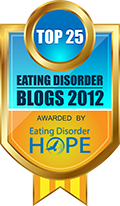1 in 20 Update
I'm temporarily putting the project on hold for several reasons.
1) I want to get the data/statistical information all sorted
and
2) I'm busy with work-related stuff so I don't necessarily have lots of time at the moment.
If any of you have good epidemiological or statistical data on ED prevalence, please feel free to share. You raised some good points, and I want to be sure everything is as accurate as possible before I go ahead.






9 comments:
Understandable. Should we pull the graphic from our blogs if we posted it? At least until you give the go-ahead again?
I have the same question as Purple Dreamer
Thanks.
Such a good scientist- and a good listener- love how you respect and respond to your readers!
The only recent paper on the epidemiology of EDs is the one that you cited in your Sunday Smorgasbord, "Epidemiology of Eating Disorders: Incidence, Prevalence and Mortality Rates." The statistical analysis looks good to my eye. Plus, it is recent. Wish I could be of more help.
Thanks everyone.
If you would feel more comfortable pulling the graphic, then please do so. I've left it up for now so that I can revise it later.
It will be at least into next week until I get this sorted--I have several deadlines and a busy weekend coming up.
Carrie, I love your blog. Its been helping me so much throughout recovery. I just wanted to share my blog with you as well...you are truly an inspiration!
http://anorexiarecovery1.blogspot.ca/
Here's one-it's missing ED-NOS in the abstract but it might be in the paper itself. If you pull it up in pub med there are some other similar studies over to the side.
Arch Gen Psychiatry. 2011 Jul;68(7):714-23. Epub 2011 Mar 7.
Prevalence and correlates of eating disorders in adolescents. Results from the national comorbidity survey replication adolescent supplement.
Swanson SA, Crow SJ, Le Grange D, Swendsen J, Merikangas KR.
Source
Genetic Epidemiology Research Branch, Intramural Research Program, National Institute of Mental Health, Bethesda, MD 20892, USA.
Abstract
CONTEXT:
Eating disorders are severe conditions, but little is known about the prevalence or correlates of these disorders from population-based surveys of adolescents.
OBJECTIVES:
To examine the prevalence and correlates of eating disorders in a large, reprefentative sample of US adolescents.
DESIGN:
Cross-sectional survey of adolescents with face-to-face interviews using a modified version of the Composite International Diagnostic Interview.
SETTING:
Combined household and school adolescent samples.
PARTICIPANTS:
Nationally representative sample of 10,123 adolescents aged 13 to 18 years.
MAIN OUTCOME MEASURES:
Prevalence and correlates of eating disorders and subthreshold conditions.
RESULTS:
Lifetime prevalence estimates of anorexia nervosa, bulimia nervosa, and binge-eating disorder were 0.3%, 0.9%, and 1.6%, respectively. Important differences were observed between eating disorder subtypes concerning sociodemographic correlates, psychiatric comorbidity, role impairment, and suicidality. Although the majority of adolescents with an eating disorder sought some form of treatment, only a minority received treatment specifically for their eating or weight problems. Analyses of 2 related subthreshold conditions suggest that these conditions are often clinically significant.
CONCLUSIONS:
Eating disorders and subthreshold eating conditions are prevalent in the general adolescent population. Their impact is demonstrated by generally strong associations with other psychiatric disorders, role impairment, and suicidality. The unmet treatment needs in the adolescent population place these disorders as important public health concerns.
PMID: 21383252 [PubMed - indexed for MEDLINE]
Carrie Arnold, WHERE ARE YOU?!? You have time to tweet and post on ATDT, but no time to update your own blog??? Get with the program girly and update this blog!
I agree with the Anonymous above...stop slacking and bring back Sunday Smorgasbord!
Post a Comment